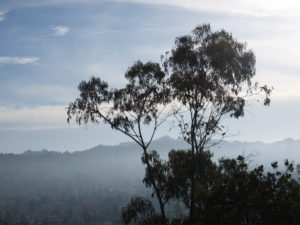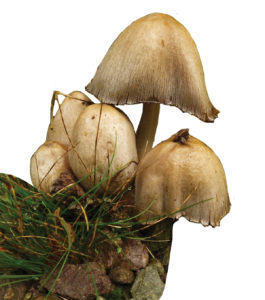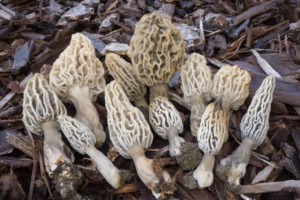In technical terms, mushrooms are the charismatic sexual reproductive structures of fungal individuals whose main body (fine, cobweb-like filaments called hyphae) is well hidden in the soil or amongst leaves and rotting wood. The primary role of the mushroom is reproduction-abundant spore production and effective spore dispersal-and its shape reflects this function. The basic strategy is to produce and disperse millions of microscopic spores quickly, so the mushroom is designed to develop rapidly (in one to seven days) and have a maximized surface area for spore production. Mushrooms exhibit many ways a large spore-bearing surface area can be designed. Underneath a cap that provides a structural foundation and protection for the developing spores, some mushrooms (including “agarics” like portobello) produce radiating plates called gills on which the spores are formed. Other species (such as “boletes” like porcini) form a spongelike structure of vertically oriented tubes inside of which the spores develop. Still others form spinelike spore-bearing structures (tooth fungi like hedgehogs). In most of these mushrooms, the spores are forcibly discharged, so the cap is elevated by a stem to ensure that the spores are re-leased into the air for effective dispersal. Some other mushrooms look like marine corals, with highly branched, erect fruit bodies; in these, the spores are produced all over the surface of the branches. Yet other mushrooms form their billions of spores inside an enclosed structure that opens only at maturity, aided by splashing rain or plodding animals, “puffing” their spores into the air (puffballs).
As for color variability, some mushrooms with unpalatable or toxic compounds are distinctively colored, perhaps to serve as a warning to potential predators. However, avoiding predation is important to mushrooms only before the spores are formed. Remember, once a mushroom has dispersed its millions of spores, it has effectively served its purpose. So if an animal eats it at maturity, the animal becomes an additional dispersal vector for the fungus. Indeed, some mushrooms are brightly colored to attract spore dispersers, analogous to brightly colored fruits that attract seed dispersers. Stinkhorns are some of the most unusual mushrooms known, often bright red and oddly shaped, like star-fish, phalluses or Wiffle balls. Their strategy is to attract flies that eat the slimy, nutritious spore mass, fly off, and defecate in a new location, where the spores then germinate in a nitrogen-rich substrate. But who knows, maybe mushrooms come in fantastic shapes and colors just to enhance the aesthetics of this planet, thereby making us humans happier and more conservation minded!




